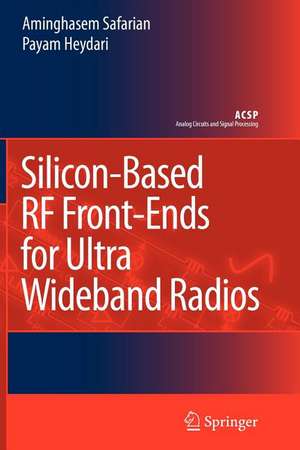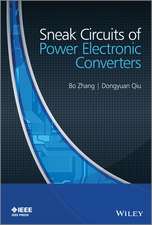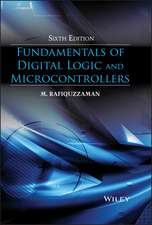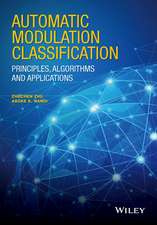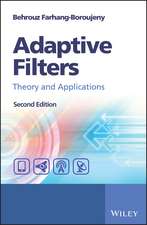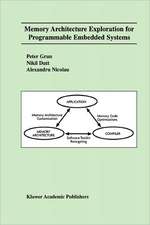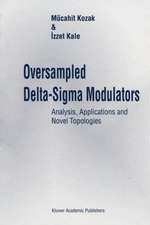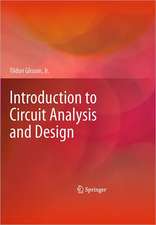Silicon-Based RF Front-Ends for Ultra Wideband Radios: Analog Circuits and Signal Processing
Autor Aminghasem Safarian, Payam Heydarien Limba Engleză Paperback – 30 noi 2010
| Toate formatele și edițiile | Preț | Express |
|---|---|---|
| Paperback (1) | 631.21 lei 6-8 săpt. | |
| SPRINGER NETHERLANDS – 30 noi 2010 | 631.21 lei 6-8 săpt. | |
| Hardback (1) | 637.28 lei 6-8 săpt. | |
| SPRINGER NETHERLANDS – 15 ian 2008 | 637.28 lei 6-8 săpt. |
Din seria Analog Circuits and Signal Processing
- 5%
 Preț: 902.97 lei
Preț: 902.97 lei - 9%
 Preț: 629.00 lei
Preț: 629.00 lei -
 Preț: 388.34 lei
Preț: 388.34 lei - 15%
 Preț: 636.30 lei
Preț: 636.30 lei - 15%
 Preț: 636.80 lei
Preț: 636.80 lei - 18%
 Preț: 941.82 lei
Preț: 941.82 lei - 15%
 Preț: 639.08 lei
Preț: 639.08 lei - 18%
 Preț: 918.48 lei
Preț: 918.48 lei - 15%
 Preț: 642.03 lei
Preț: 642.03 lei - 15%
 Preț: 641.85 lei
Preț: 641.85 lei - 18%
 Preț: 887.05 lei
Preț: 887.05 lei - 18%
 Preț: 944.51 lei
Preț: 944.51 lei - 15%
 Preț: 632.55 lei
Preț: 632.55 lei - 15%
 Preț: 641.03 lei
Preț: 641.03 lei - 18%
 Preț: 836.39 lei
Preț: 836.39 lei - 15%
 Preț: 642.18 lei
Preț: 642.18 lei - 15%
 Preț: 639.90 lei
Preț: 639.90 lei - 18%
 Preț: 947.85 lei
Preț: 947.85 lei - 15%
 Preț: 642.51 lei
Preț: 642.51 lei - 15%
 Preț: 631.86 lei
Preț: 631.86 lei - 15%
 Preț: 634.49 lei
Preț: 634.49 lei - 15%
 Preț: 635.47 lei
Preț: 635.47 lei - 15%
 Preț: 640.06 lei
Preț: 640.06 lei - 15%
 Preț: 631.53 lei
Preț: 631.53 lei - 15%
 Preț: 635.65 lei
Preț: 635.65 lei - 18%
 Preț: 941.50 lei
Preț: 941.50 lei - 18%
 Preț: 1112.92 lei
Preț: 1112.92 lei - 15%
 Preț: 636.30 lei
Preț: 636.30 lei - 15%
 Preț: 633.19 lei
Preț: 633.19 lei - 15%
 Preț: 635.80 lei
Preț: 635.80 lei - 18%
 Preț: 888.01 lei
Preț: 888.01 lei - 18%
 Preț: 942.76 lei
Preț: 942.76 lei - 18%
 Preț: 1387.10 lei
Preț: 1387.10 lei - 18%
 Preț: 1115.28 lei
Preț: 1115.28 lei - 15%
 Preț: 633.68 lei
Preț: 633.68 lei - 15%
 Preț: 641.03 lei
Preț: 641.03 lei - 15%
 Preț: 638.57 lei
Preț: 638.57 lei - 15%
 Preț: 642.51 lei
Preț: 642.51 lei - 18%
 Preț: 947.85 lei
Preț: 947.85 lei - 15%
 Preț: 640.71 lei
Preț: 640.71 lei - 15%
 Preț: 640.88 lei
Preț: 640.88 lei - 15%
 Preț: 631.40 lei
Preț: 631.40 lei - 18%
 Preț: 944.19 lei
Preț: 944.19 lei - 18%
 Preț: 944.67 lei
Preț: 944.67 lei - 18%
 Preț: 942.94 lei
Preț: 942.94 lei - 15%
 Preț: 641.20 lei
Preț: 641.20 lei - 20%
 Preț: 555.53 lei
Preț: 555.53 lei - 18%
 Preț: 1003.38 lei
Preț: 1003.38 lei
Preț: 631.21 lei
Preț vechi: 742.60 lei
-15% Nou
Puncte Express: 947
Preț estimativ în valută:
120.78€ • 126.12$ • 99.74£
120.78€ • 126.12$ • 99.74£
Carte tipărită la comandă
Livrare economică 15-29 aprilie
Preluare comenzi: 021 569.72.76
Specificații
ISBN-13: 9789048177059
ISBN-10: 9048177057
Pagini: 108
Ilustrații: VIII, 97 p.
Dimensiuni: 155 x 235 x 6 mm
Greutate: 0.16 kg
Ediția:Softcover reprint of hardcover 1st ed. 2008
Editura: SPRINGER NETHERLANDS
Colecția Springer
Seria Analog Circuits and Signal Processing
Locul publicării:Dordrecht, Netherlands
ISBN-10: 9048177057
Pagini: 108
Ilustrații: VIII, 97 p.
Dimensiuni: 155 x 235 x 6 mm
Greutate: 0.16 kg
Ediția:Softcover reprint of hardcover 1st ed. 2008
Editura: SPRINGER NETHERLANDS
Colecția Springer
Seria Analog Circuits and Signal Processing
Locul publicării:Dordrecht, Netherlands
Public țintă
ResearchCuprins
Ultra Wideband Systems.- UWB Distributed Low Noise Amplifiers (DLNA).- Distributed RF Front-End.- Distributed RF Front-End for UWB Direct Conversion Receiver.- Distributed Active Power Combiners and Splitters for Multi-Antenna UWB Beamforming Transceivers.- Conclusions.
Notă biografică
Aminghasem Safarian received the B.S. and M.S. degrees in electrical engineering from the Sharif University of Technology, in 2000, 2002, respectively. He received the Ph.D. degree in electrical engineering from the University of California, Irvine, in 2006. He is currently with Broadcom Corporation as a staff scientist working on RF ICs for wireless applications.
Payam Heydari received the B.S. and M.S. degrees in electrical engineering from the Sharif University of Technology, in 1992, 1995, respectively. He received the Ph.D. degree in electrical engineering from the University of Southern California, in 2001.
During the summer of 1997, he was with Bell-Labs, Lucent Technologies, where he worked on noise analysis in deep submicron very large-scale integrated (VLSI) circuits. During the summer of 1998, he was with IBM T. J. Watson Research Center, Yorktown Heights, NY, where he worked on gradient-based optimization and sensitivity analysis of custom-integrated circuits. He is currently an Associate Professor of Electrical Engineering at the University of California, Irvine, where his research interest is on the design of high-performance analog and RF ICs. He has published more than 50 papers in premier conferences on integrated circuit design including ISSCC, CICC, RFIC Symposium, DAC, ICCAD.
Dr. Heydari is the Associate Editor of IEEE Trans. on Circuits and Systems, I. He currently serves on the Technical Program Committees of Custom Integrated Circuits Conference (CICC), International Symposium on Low-Power Electronics and Design (ISLPED), and International Symposium on Quality Electronic Design (ISQED).
Dr. Heydari is the recipient of the 2005 National Science Foundation (NSF) CAREER Award, the 2005 IEEE Circuits and Systems Society Darlington Award, the 2005 Henry Samueli School of Engineering Teaching Excellence Award, the Best Paper Award at the 2000 IEEE International Conference on Computer Design (ICCD). His name was included in the 2006 Who's Who in Science and Engineering.
Payam Heydari received the B.S. and M.S. degrees in electrical engineering from the Sharif University of Technology, in 1992, 1995, respectively. He received the Ph.D. degree in electrical engineering from the University of Southern California, in 2001.
During the summer of 1997, he was with Bell-Labs, Lucent Technologies, where he worked on noise analysis in deep submicron very large-scale integrated (VLSI) circuits. During the summer of 1998, he was with IBM T. J. Watson Research Center, Yorktown Heights, NY, where he worked on gradient-based optimization and sensitivity analysis of custom-integrated circuits. He is currently an Associate Professor of Electrical Engineering at the University of California, Irvine, where his research interest is on the design of high-performance analog and RF ICs. He has published more than 50 papers in premier conferences on integrated circuit design including ISSCC, CICC, RFIC Symposium, DAC, ICCAD.
Dr. Heydari is the Associate Editor of IEEE Trans. on Circuits and Systems, I. He currently serves on the Technical Program Committees of Custom Integrated Circuits Conference (CICC), International Symposium on Low-Power Electronics and Design (ISLPED), and International Symposium on Quality Electronic Design (ISQED).
Dr. Heydari is the recipient of the 2005 National Science Foundation (NSF) CAREER Award, the 2005 IEEE Circuits and Systems Society Darlington Award, the 2005 Henry Samueli School of Engineering Teaching Excellence Award, the Best Paper Award at the 2000 IEEE International Conference on Computer Design (ICCD). His name was included in the 2006 Who's Who in Science and Engineering.
Textul de pe ultima copertă
Ultra-wideband (UWB) is a promising technology for high speed short distance communication, as well as low data-rate low power communication for object localization and sensor networks. The most important characteristic of UWB is the operation in power-limited regime while achieving high channel capacity. The main challenge lies in designing transceivers for wideband signals.
Distributed integrated circuits provide intrinsic wideband characteristics, which makes them potential candidate for use in UWB transceivers. Recent advances in high-speed IC design with continuous scaling of minimum feature sizes of silicon technologies have renewed the interest in distributed circuits using on-chip transmission lines.
Silicon-Based RF Front-Ends for UWB Radios comprehensively studies silicon-based distributed architectures in wideband circuits.
The book begins with an introduction of several transceiver architectures for UWB. The discussion then focuses on RF front-end of the UWB radio. First, the design and analysis of a performance-optimized CMOS distributed LNA is presented. This is followed by design of novel distributed RF front-ends for UWB IF-receivers (UWB-DRF). The book continues with the introduction of a novel distributed direct conversion RF front-end (DDC-RF). The DDC-RF power and area-efficiently combines the wideband distributed approach with IQ requirement of a direct conversion receiver. Furthermore, deploying merged LNA/mixer enables low-power design, while achieving superior linearity over the conventional distributed amplifiers. The baseband output signals are zero/ low-IF, hence the output transmission lines in conventional distributed circuits are omitted, resulting in less area of the DDC-RF.
To increase data rate and to achieve immunity to multi-path fading, UWB systems employs multi-antenna configuration at receiver/transmitter. Innovative wideband variable delay and gain stages are then introduced to receive and transmit in desired direction. Finally, experimental results of the fabricated prototypes are presented.
Silicon-Based RF Front-Ends for UWB Radios will be of interest to RF circuit designers and students.
Distributed integrated circuits provide intrinsic wideband characteristics, which makes them potential candidate for use in UWB transceivers. Recent advances in high-speed IC design with continuous scaling of minimum feature sizes of silicon technologies have renewed the interest in distributed circuits using on-chip transmission lines.
Silicon-Based RF Front-Ends for UWB Radios comprehensively studies silicon-based distributed architectures in wideband circuits.
The book begins with an introduction of several transceiver architectures for UWB. The discussion then focuses on RF front-end of the UWB radio. First, the design and analysis of a performance-optimized CMOS distributed LNA is presented. This is followed by design of novel distributed RF front-ends for UWB IF-receivers (UWB-DRF). The book continues with the introduction of a novel distributed direct conversion RF front-end (DDC-RF). The DDC-RF power and area-efficiently combines the wideband distributed approach with IQ requirement of a direct conversion receiver. Furthermore, deploying merged LNA/mixer enables low-power design, while achieving superior linearity over the conventional distributed amplifiers. The baseband output signals are zero/ low-IF, hence the output transmission lines in conventional distributed circuits are omitted, resulting in less area of the DDC-RF.
To increase data rate and to achieve immunity to multi-path fading, UWB systems employs multi-antenna configuration at receiver/transmitter. Innovative wideband variable delay and gain stages are then introduced to receive and transmit in desired direction. Finally, experimental results of the fabricated prototypes are presented.
Silicon-Based RF Front-Ends for UWB Radios will be of interest to RF circuit designers and students.
Caracteristici
Novel circuit architectures for ultra-wideband (UWB) wireless technologies Low power and small area distributed circuits Performance optimized distributed circuits Unveiling new multi-antenna UWB transceiver architectures with beamforming
